Hey there, fashion explorers! Ever heard of Toda embroidery from the Nilgiris? If not, get ready to meet the diva of the handcraft world – bold, elegant, and with just the right amount of drama stitched in. This isn’t your average “grandma’s needlework” (no offense, grandma) – Toda Embroidery is a centuries-old tribal art from the scenic Nilgiri Hills in Tamil Nadu, made by the Toda community, who have mastered the art of turning red, black, and white threads into geometric perfection.
Did you know? A single Toda shawl can take over 3 weeks to make, and luxury brands now sell them for prices that could fund a weekend in Paris! No wonder fashion giants are sliding these tribal stitches onto runways from Milan to New York. In a world of fast fashion, Toda Embroidery is slow, soulful, and seriously stylish – proof that ancient hands can set modern trends.
The Charm of Toda Embroidery and Its Tribal Heritage
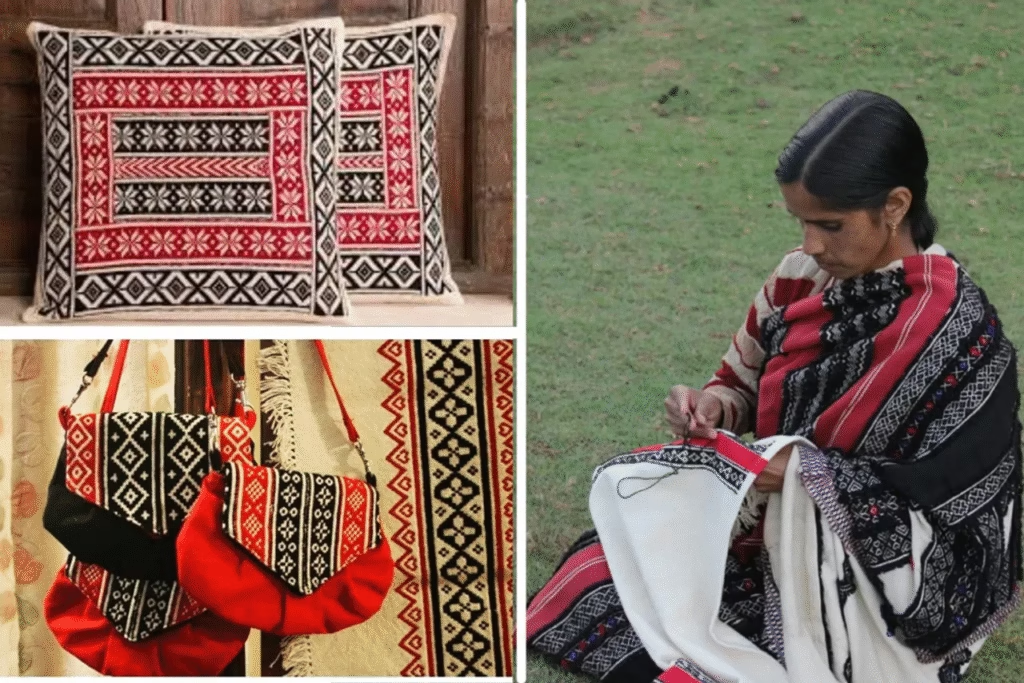
Imagine a blanket of mist over the Nilgiri Hills, the air scented with wildflowers, and women in bright shawls threading stories into fabric – that’s the magic of Toda embroidery. Created by the Toda tribe of Tamil Nadu, this art form is more than just “pretty stitches.” It’s cultural storytelling wrapped in red, black, and white geometric designs. Every pattern has meaning – some celebrate nature, others mark special occasions.
Fun fact: Traditionally, Toda women stitch without drawing outlines. Yep, no pencil marks, no tracing – just pure skill and a steady hand. And it’s not done in a hurry either. One shawl can take 15–25 days to complete. Talk about patience!
This embroidery isn’t mass-produced. It’s slow fashion at its finest – each piece unique, just like a fingerprint. No wonder it’s now attracting attention far beyond the green slopes of the Nilgiris.
Why Luxury Brands Are Embracing Traditional Stitches
- Exclusivity sells – No two pieces of Toda embroidery are ever the same. Each design is handmade by skilled tribal artisans, making every piece a one-of-a-kind treasure that no machine can copy.
- Sustainability is trending – Toda embroidery is made using 100% handwoven, eco-friendly fabrics and natural threads. It’s slow fashion at its best, supporting the planet while creating timeless beauty.
- Authentic storytelling – Every stitch in Toda embroidery carries a story of the Nilgiris tribe, their traditions, and their culture, turning fabric into a living history book.
- Luxury loves detail – The fine, precise needlework in Toda embroidery can rival the most delicate haute couture designs, making it a perfect fit for luxury fashion.
Today, top fashion houses see Toda embroidery as the perfect blend of heritage and high-end elegance. Limited edition jackets, scarves, and dresses featuring these intricate tribal stitches are now showcased in luxury boutiques in Paris, Milan, and New York. This isn’t just clothing – it’s wearable history, crafted with care, tradition, and timeless style.
How the Nilgiris Craft is Making Waves in High-End Markets
- Runway ready – Fashion designers are giving Toda embroidery a glamorous twist by pairing its bold red-and-black patterns with flowing silk gowns, tailored linen jackets, and even evening clutches.
- Celebrity stamp – From red carpet events to airport looks, several A-list celebrities have been spotted wearing Toda embroidery-inspired scarves, handbags, and belts, turning the craft into a style statement.
- Cultural luxury – In a world where luxury buyers crave meaning, Toda embroidery stands out. Each piece carries a cultural backstory, making it more than just fashion – it’s a conversation starter.
- Price tag power – In premium markets, finely hand-embroidered Toda shawls and stoles now sell for $500 or more, thanks to the time, skill, and tradition woven into each piece.
From the peaceful hills of the Nilgiris to the buzzing world of haute couture, Toda embroidery is proving that tradition never goes out of style. It doesn’t just survive in modern fashion – it walks the runway with confidence, elegance, and a story worth telling.
The Roots of Toda Embroidery
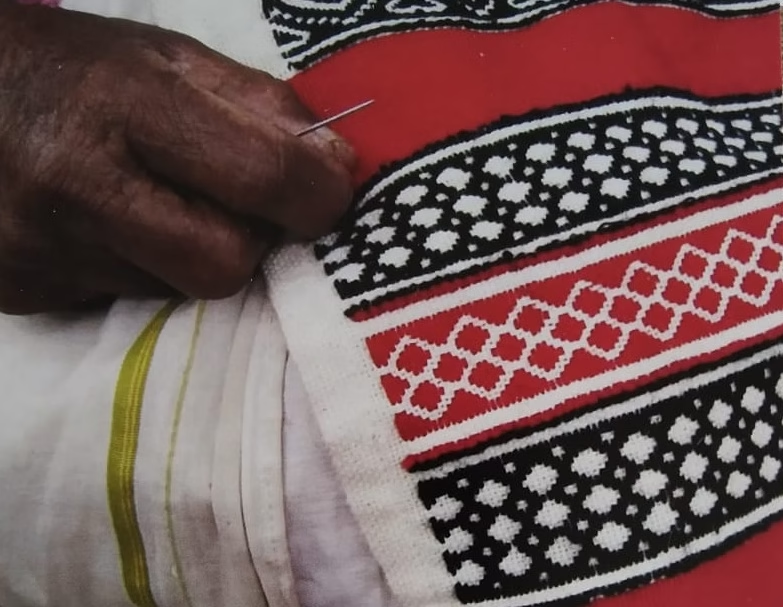
The story of Toda Embroidery begins high up in the misty Nilgiri Hills of Tamil Nadu, where the Toda tribe has lived for centuries. This small community, with just about 2,000–2,200 people, is known for its buffalo herding, unique half-barrel houses, and a rich tradition of hand embroidery that has captured global attention. Their craft isn’t just about making clothes look pretty – it’s a woven record of culture, belief, and pride.
Traditionally, Toda women hand-stitch geometric patterns on thick white cotton cloth using red and black wool threads. The process is slow and detailed, with some shawls taking three to four weeks to complete. Each motif carries meaning – from nature-inspired shapes to symbols of strength. Today, this tribal art has stepped beyond the hills, winning UNESCO recognition as an Intangible Cultural Heritage and catching the eyes of luxury fashion brands worldwide. In a world of mass production, Toda Embroidery proudly stays handmade, heartfelt, and timeless.
Who Are the Toda People?
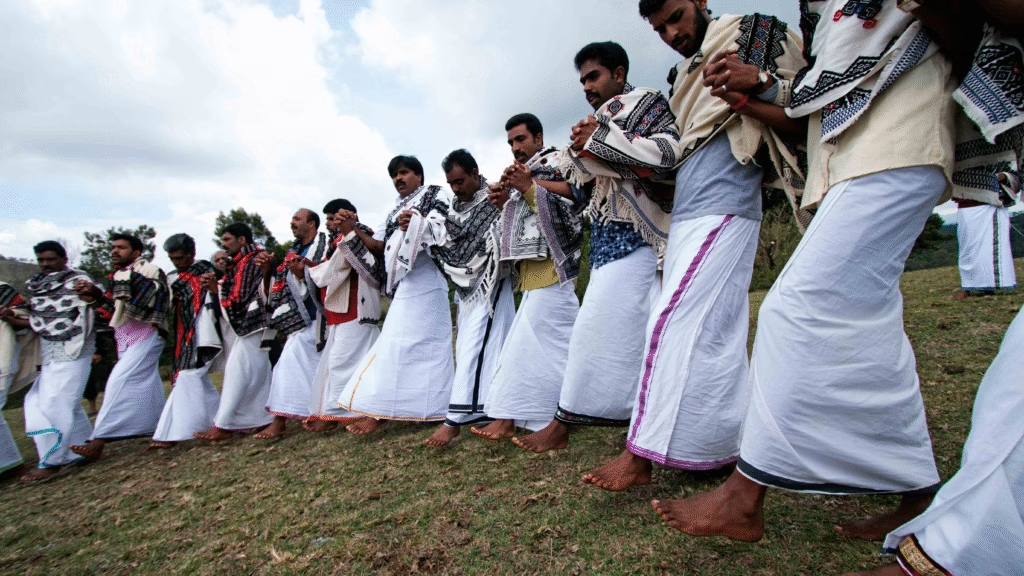
High up in the scenic Nilgiri Hills of Tamil Nadu lives a small but unique community – the Toda people. They are among India’s tiniest tribal groups, yet their culture, traditions, and craft have made a big mark on the world. Toda embroidery, their most famous art form, is not just a design but a living expression of their heritage. Here’s a closer look at their life:
- A small but proud community – The Toda tribe has only about 2,000–2,200 members, making them one of the smallest communities in India, yet their culture is incredibly rich.
- Homes with a twist – They live in half-barrel-shaped huts called dogles, which are as unique as their embroidery.
- Buffalo love – Buffaloes play a central role, providing milk, featuring in rituals, and even inspiring local myths.
- The women behind the stitches – Toda embroidery is crafted by women, who learn the skill from a young age.
- A peaceful way of life – They value harmony with nature, sustainable living, and keeping traditions alive.
Even in today’s fast-paced world, the Toda people proudly keep their identity alive through traditional dress, customs, and their iconic Toda embroidery.
Cultural Significance of the Embroidery in Daily and Ceremonial Life
Toda embroidery is much more than a fashion statement – it is woven into the very fabric of the Toda people’s daily life and traditions. Every thread carries meaning, and every pattern is linked to a moment, memory, or ritual. Whether it’s a happy festival or a solemn ceremony, this embroidery plays a central role in expressing identity and preserving heritage. Here’s how it is used:
- Daily wear – Women often wear beautifully embroidered pukhoor shawls during community gatherings, adding elegance to everyday life.
- Festivals – During religious and seasonal celebrations, Toda embroidery appears in its brightest and most detailed forms.
- Weddings – Brides wear heavily embroidered shawls, symbolizing beauty, purity, and tradition.
- Funerals – Simple white shawls with minimal designs mark respect and mourning.
- Storytelling – Patterns often depict nature, animals, and ancient myths.
- Community pride – Wearing Toda embroidery shows belonging and unity.
- Gifting tradition – Handcrafted shawls are exchanged during important events.
- Generational transfer – Mothers teach daughters the skill, keeping it alive.
In every stitch, Toda embroidery reflects resilience, artistry, and the heart of the Toda community.
The Unique Red, Black, and White Color Palette
One of the most striking features of Toda embroidery is its bold and meaningful color palette. For generations, the Toda people have stuck to three main colors – white, red, and black – each carrying deep symbolism. These shades are not just for beauty; they are part of the tribe’s identity and traditions, making the embroidery instantly recognizable anywhere in the world. Here’s what each element means:
- White – The base cloth is always white, symbolizing purity, peace, and a clean foundation for life and art.
- Red – This vibrant shade stands for strength, energy, and joy, bringing life to every pattern.
- Black – Used to outline and fill, black adds depth, elegance, and clear definition to the designs.
- Tradition and technique – About 90% of authentic Toda embroidery uses only these three colors, paired with a unique reverse darning method that creates a slightly raised texture.
- Motifs and recognition – Designs often feature buffalo horns, temples, flowers, and geometric patterns, making them timeless yet deeply tribal.
This simple yet powerful trio is why Toda embroidery is loved by global luxury brands and fashion runways alike.
Crafting the Magic: How Toda Embroidery is Made
Step into the charming hills of the Nilgiris, and you’ll find the Toda women creating magic with a needle and thread. Toda embroidery isn’t just a craft; it’s a slow-cooked recipe of patience, precision, and tradition passed down through generations. Imagine someone spending hours stitching… not for Instagram likes, but for pure love of art. The Toda community, known for their bright red, black, and white designs, still follows age-old methods.
Fun fact: Around 80% of Toda women are skilled in this craft, and most begin learning as teenagers. The result? Shawls, cloaks, and accessories so gorgeous, even luxury brands can’t resist flaunting them on global runways. And yes, these aren’t made in big noisy factories – each piece is hand-stitched, making every single one unique.
Materials and Tools Used by Artisans
Toda embroidery is a true example of how beautiful things can be made with the simplest of tools. The craft has been passed down for generations without needing modern machines or complicated equipment. Every piece is made by hand, using materials that are both traditional and practical. Here’s what artisans use to create this timeless embroidery:
- Fabric – Traditionally, a thick white cotton cloth is chosen as the base. Its durability ensures the embroidery lasts for years, while its pure color allows the red and black threads to stand out beautifully.
- Threads – Wool or cotton threads in bold red and black are the most common, sometimes with a touch of blue for special designs. These colors are part of the Toda tribe’s signature style.
- Needle – A simple hand needle is all that’s needed. No sewing machines are used – every stitch is placed with care and precision.
- Frames or Hoops – Unlike other embroidery styles, Toda women often skip hoops and frames, preferring to hold the cloth in their hands as they work.
With such simple tools, Toda embroidery turns plain fabric into a masterpiece filled with culture and history.
The Reverse Stitching Technique Explained
One of the most fascinating things about Toda embroidery is the way it’s made. Unlike most embroidery styles where you stitch from the front and see the design as it grows, this craft has its own magical twist. The artisan starts on the back side of the cloth, working completely by touch and memory, trusting that the pattern will appear perfectly on the front. Here’s how it works:
- Backside stitching – Every piece of Toda embroidery is created from the reverse side of the fabric. The artisan doesn’t see the finished design until they flip it over.
- Working blind – Just like baking a cake without opening the oven, they trust their skill and years of practice to get it right.
- Pattern creation – Using this method, geometric patterns slowly emerge, often inspired by nature, animals, buffalo horns, and sacred Toda symbols.
- Patience and precision – Since the design can’t be checked while stitching, every movement has to be exact.
This reverse stitching technique is what gives Toda embroidery its slightly raised texture, adding depth, charm, and a touch of mystery to every piece.
Time and Patience: Why Each Piece is a Work of Art
Toda embroidery is not something that can be rushed. Every piece is made slowly, carefully, and with deep respect for tradition. The process demands time, patience, and an eye for perfection. That’s why when you see a Toda embroidered shawl, you’re not just looking at fabric – you’re looking at weeks of dedicated craftsmanship. Here’s why it takes so long:
- Tiny, precise stitches – Each stitch is small, neat, and perfectly placed, which takes a lot of concentration and steady hands. Even a single mistake means starting over.
- Complex symmetrical patterns – The designs are carefully planned so that both sides of the shawl match beautifully, making the process even more detailed.
- Zero shortcuts – Every thread is placed by hand, without machines or templates, keeping the work 100% authentic.
On average, a single Toda embroidery shawl can take 20–30 days to complete. That’s why owning one is like wearing a piece of living history – a blend of art, culture, and timeless style that you simply can’t mass-produce.
From Local to Luxury: The Global Journey
Toda embroidery has taken quite a stylish journey – from being a treasured tribal craft in the Nilgiri Hills to becoming a star in the world of luxury fashion. Once, these red, black, and white geometric stitches were created mainly for community rituals, weddings, and local use. The designs carried stories of nature, culture, and tradition, with every piece made lovingly by hand.
Fast forward to today, and this ancient art is rubbing shoulders with high-end brands like Gucci and Dior. Imagine that friend who once wore simple kurtas in college but now struts in designer gowns at Paris Fashion Week – that’s the glow-up Toda embroidery has had!
Global designers are drawn to its authenticity, striking colors, and meaningful patterns, turning it into a favorite for limited-edition collections. From the peaceful hills of Tamil Nadu to the glamorous runways of Milan and New York, Toda embroidery proves that when tradition meets trend, the result is pure fashion magic.
How Designers Discovered Toda Embroidery
The journey of Toda embroidery into the world of high fashion began with a mix of curiosity, travel, and a love for culture. It started when adventurous travelers and culture-loving fashion designers visited the Nilgiri Hills and stumbled upon this unique tribal craft. A few lucky features in lifestyle and fashion magazines gave it more attention, and soon designers realized that this embroidery wasn’t just “pretty” – it was a piece of living history. The precision, symbolism, and handmade beauty made it feel like something worthy of an art gallery. Here’s what caught their attention:
- Zero machine work – Every single stitch in Toda embroidery is made by hand, giving it a warmth and authenticity that machines simply can’t copy.
- Each piece unique – No two designs are ever the same, making every shawl, scarf, or accessory a one-of-a-kind masterpiece.
- Cultural depth – Every pattern is inspired by nature, traditions, and stories of the Toda tribe, adding meaning far beyond decoration.
With these qualities, it was only a matter of time before Toda embroidery found its place in couture collections.
Collaborations with International Fashion Houses
Fast forward, and Toda embroidery found itself in the mood boards of top global labels. Imagine tribal artisans from the Nilgiris swapping ideas with Paris design studios – talk about a cultural cocktail! These collaborations led to:
- Designer jackets with Toda motifs.
- Tote bags featuring Toda patterns.
- Limited-edition scarves are sold in Milan boutiques.
Some pieces even sold for over $1,500 each, making Toda artisans realize their needle might just be a golden wand.
Features in Fashion Weeks and Global Runway Shows
From Lakmé Fashion Week to London and Milan runways, Toda designs are now show-stoppers. In fact, 2023 saw a 60% rise in Indian tribal arts being showcased at international fashion events. Models strut in statement coats, capes, and accessories embroidered by Toda women, while audiences gasp (and Instagram explodes).
And just like that, what began in a small Nilgiri village is now turning heads under blinding runway lights – proving fashion has no borders, only threads that connect worlds.
The Future: Sustainable Fashion & Cultural Pride
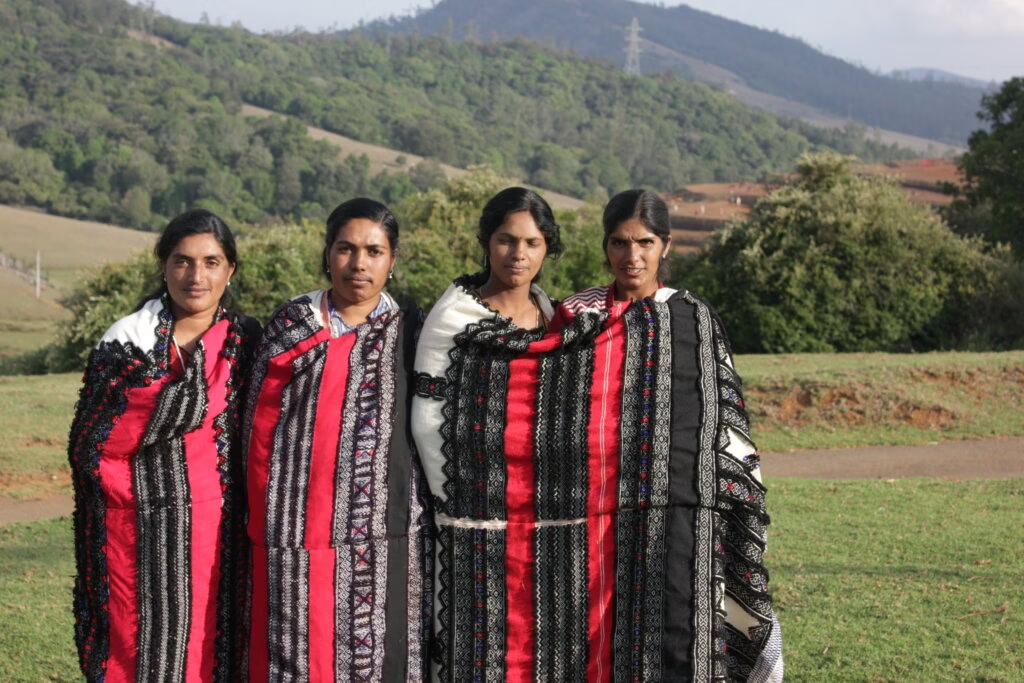
If you think the future of luxury is all about robots sewing rhinestones, think again! The real runway stars are crafts like Toda Embroidery – ancient, soulful, and now totally trending in eco-friendly fashion. As the world gets more conscious about what we wear, sustainable styles are winning over fast fashion. And let’s be honest – there’s something far more glamorous about saying, “Oh, this? It’s hand-embroidered by the Toda tribe in the Nilgiris” than “I got it from a 5-minute flash sale.”
Designers are now teaming up with Toda artisans to create stunning, zero-waste luxury pieces that don’t just look good – they do good. Think organic cotton, natural dyes, and timeless patterns that never go out of style.
In fact, recent reports show that over 60% of luxury consumers are now choosing sustainable options. So yes, in a world where trends change faster than your Wi-Fi speed, Toda Embroidery is here to stitch cultural pride into the future of fashion.
Toda Embroidery in Eco-Friendly Luxury Trends
In a world where fashion is becoming more mindful of the planet, Toda embroidery from the Nilgiris fits perfectly into the eco-luxury movement. This tribal craft blends sustainability with elegance, making it a favorite for designers who want beauty without harming nature. Every piece is made with care, love, and respect for the environment. Here’s why it’s making waves in eco-friendly fashion:
- Organic fabrics + hand embroidery – Toda embroidery is often done on thick organic cotton or handwoven cloth, paired with skilled, 100% handmade stitching – a true fashion match made in heaven.
- Natural dyes – The colors come from natural, eco-safe dyes, ensuring no harmful chemicals damage the planet or the wearer’s skin.
- Uniqueness in every piece – No two Toda embroidery shawls or accessories are ever identical, adding value and exclusivity.
- Luxury with conscience – Global luxury brands are now adding Toda embroidery details to scarves, jackets, handbags, and even couture gowns, making it the “it” accessory for eco-conscious fashion lovers.
By combining tradition with sustainability, Toda embroidery from the Nilgiris proves that style can be both stunning and planet-friendly.
Empowering Local Women Through Global Exposure
Behind every beautiful piece of Toda embroidery from the Nilgiris is a skilled pair of hands – and most often, they belong to Toda women. These women are the guardians of this ancient craft, passing it down from mothers to daughters for generations. As global interest in Toda embroidery grows, so do opportunities for these artisans to earn, grow, and shine. Here’s how the world is making a difference:
- Women at the heart of the craft – Toda embroidery is mainly created by women, who spend weeks perfecting each design with patience and precision.
- Fair trade partnerships – Collaborations with ethical and fair trade brands ensure better wages, stable income, and respect for their hard work.
- Global demand – With luxury brands and fashion lovers embracing Toda embroidery, tribal artisans are gaining the recognition they have always deserved.
- Empowerment through sales – Every purchase directly supports these women, helping them become financially independent while keeping their cultural heritage alive.
By wearing Toda embroidery from the Nilgiris, you’re not just buying fashion – you’re empowering women and protecting a priceless tradition.
Keeping the Craft Alive for the Next Generation
Toda embroidery from the Nilgiris is a treasure that deserves to live on for centuries. While it has found its way into luxury markets and global fashion, the heart of this art lies in the hands of the Toda people. To ensure that it doesn’t fade away with time, efforts are being made both locally and internationally to pass it on to the younger generation. Here’s how the tradition continues:
- Craft workshops in the Nilgiris – Local programs train younger Toda women, teaching them the stitching techniques, motifs, and cultural meaning behind every pattern.
- Social media awareness – Platforms like Instagram and YouTube showcase Toda embroidery to a global audience, inspiring appreciation and demand.
- Designer collaborations – Working with modern fashion designers keeps the craft relevant and trendy, ensuring it appeals to younger buyers too.
Because honestly, the only thing sadder than a fashion faux pas is losing a beautiful, centuries-old tradition. With each stitch, Toda embroidery continues to tell its story, connecting the past with the future.
Final Takeaway
From the misty hills of Tamil Nadu to the spotlight of global fashion runways, Toda embroidery from the Nilgiris has truly stitched its way into hearts across the world. This isn’t just about pretty patterns – it’s about a living tradition, a proud culture, and the hands of skilled Toda women who pour time, patience, and love into every piece.
In a world filled with mass-produced clothes, Toda embroidery stands out as something rare and real. It blends style with sustainability, giving fashion lovers a chance to look good while doing good. Every shawl, jacket, or accessory is more than fabric – it’s a story, a memory, and a piece of heritage.
Whether it’s empowering local women, preserving age-old skills, or adding a touch of eco-friendly luxury to your wardrobe, Toda embroidery proves that true beauty is timeless. And as long as there are needles, threads, and stories to tell, this art will keep inspiring fashion for generations to come.

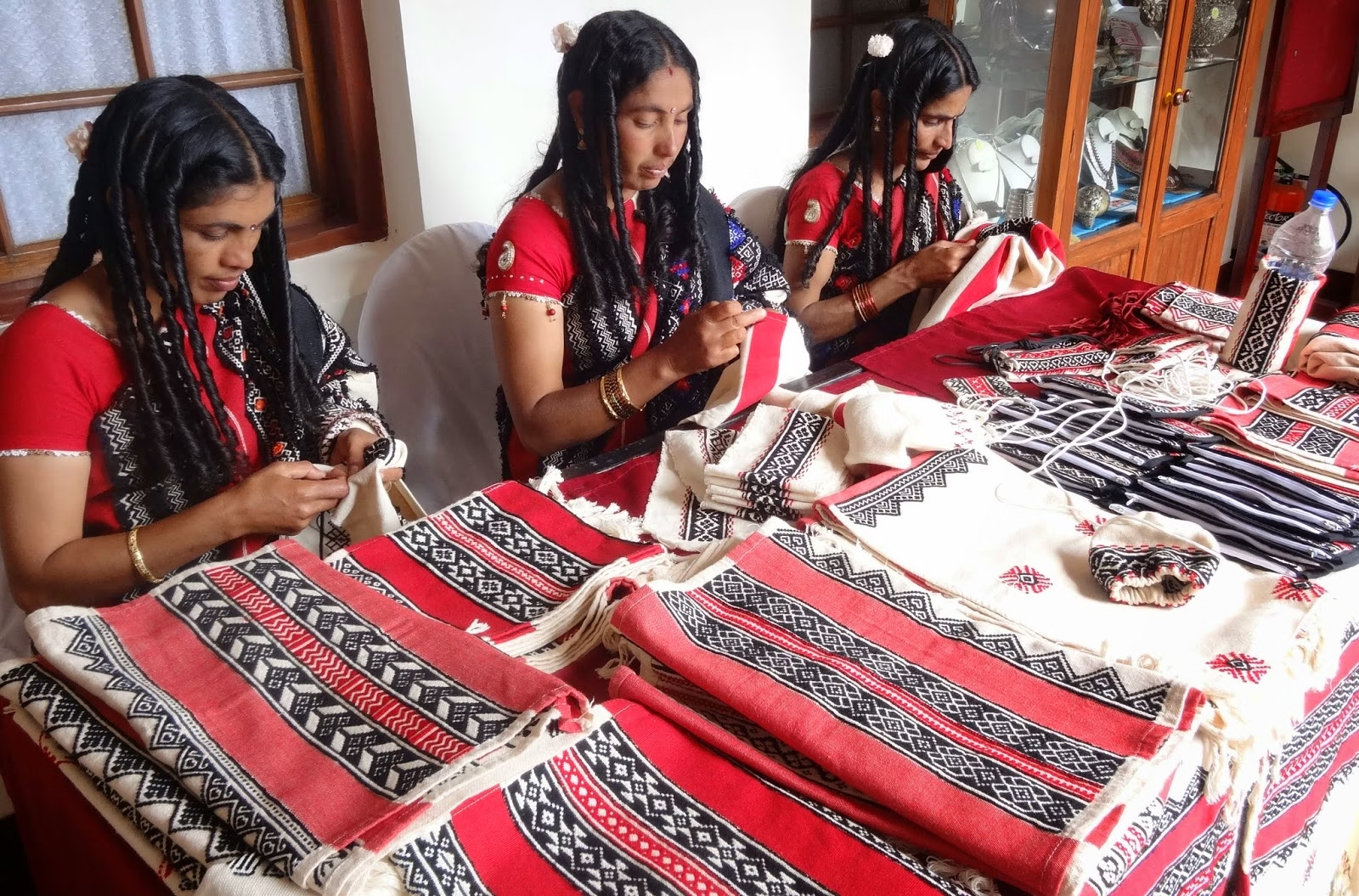
Leave a Reply